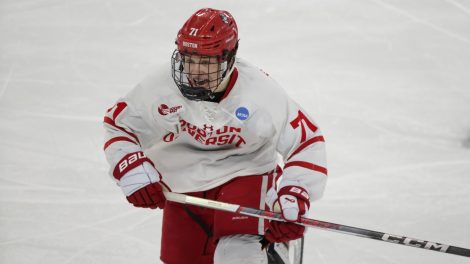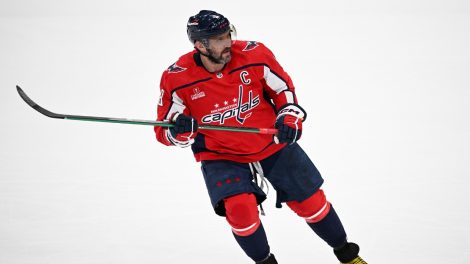NHL players are either the cleanest athletes in the sporting world, or the NHL’s “Performance Enhancing Substances Program” has some serious work to do.
You decide.
But first, consider:
On Tuesday another small fish in Shawn Horcoff joined the likes of Zenon Konopka and Sean Hill as players suspended under the program. Every few years, a suspension announcement pushes us to point out the basic, head-scratching numbers behind the NHL/NHLPA’s Performance Enhancing Substances Program:
10 years — The span in which the NHL has publicly suspended only three NHL players for PED use (listed above).
800 players — The conservative, round-number estimate of how many men skate in an NHL game each season.
$2.6 million U.S. — That’s the average salary in the NHL. Consider how many bobsledders, cross country skiers, shot putters and cyclists have tested positive for PEDs in a quest for financial gains of perhaps 10 per cent of the average NHL salary.
So, 800 players a season. Eleven seasons. Mega, mega millions at stake, yet while Major League Baseball has issued 35 drug suspensions since 2007, the NHL is stuck at three.
Why the disparity?
In concert with its players’ union — under current NHLPA head Donald Fehr — MLB turned a blind eye to systemic steroid usage in the late 1990s and early 2000s. Today MLB, under a new and strengthened program, can say it has suspended such star players as Alex Rodriguez, Manny Ramirez, Ryan Braun and Melky Cabrera.
The NHL, meanwhile, has managed to catch fourth-liners and seventh defencemen using PEDs.
On Tuesday, the NHL blew the dust off its program and nabbed one of the most respected, veteran leaders in the game today — yet a dispensable player who won’t be missed by the Ducks, as his expiry date is near — and suspended him for 20 games.
Think about it: Horcoff is 37 years old and at the end of the line. He has made just shy of $50 million as an NHL player, according to generalfanager.com.
He is a smart, responsible family man who doesn’t need the paycheck. Yet Horcoff says he took a treatment to get himself back in the game that was so egregious, it tripped the wires of the NHL/NHLPA program.
“While recovering from an injury I suffered this past fall, I tried a treatment that I believed would help speed up the healing process,” Horcoff said in a release Tuesday.
“Although I was unaware that this treatment was not permitted under NHL rules, that is no excuse whatsoever. I should have done my research and I should have checked with the NHL/NHLPA Performance Enhancing Substances Program’s doctors. I accept full responsibility for my actions, and I am sorry.”
Now, think about a young player with no other options outside of hockey; a guy who is going back to his Dad’s mill if hockey doesn’t pan out. Or back to Belarus, or Northern Finland.
If you believe the NHL/NHLPA program is doing its job, then not a single one of those players uses PEDs in hockey — even though they are used in other sports with unarguable regularity.
You might say, “So many of the baseball players are using steroids to get off some poverty-stricken Caribbean island. They’re different than hockey players.”
Well, the NHL has averaged 25 Russian-born players per season over the past decade. Russia, which at this time has seen its entire track and field team excluded from the upcoming summer Olympics, is at best a nation whose PED culture runs generations deep.
Tests conducted at the 2009 World Championships of Athletics, where Russia won 13 medals, “strongly suggest a systematic abuse of blood doping or EPO-related products,” former IAAF official Pierre Weiss has said.
We’re not saying all Russians cheat — let’s be clear about that. But 25 Russian players per season for 10 years, and while Russians in other sports have proven exceptionally prone to PED use, should we believe none of that country’s hockey players are?
You might say, “PEDs don’t help in hockey. Guys don’t want to bulk up.”
Forgive me, but that’s simply steroid ignorance.
In the old days of the Chuck Norris Division, plenty of fighters were said to be using the same kind of mass-building steroids that Jose Canseco and Mark McGwire used. Today, it’s about sustaining your power for longer; having more oxygen-carrying red blood cells in your blood stream, as EPO provides, for the final 15 seconds of a 45-second shift, when most goals are scored.
The Olympic movement learned long ago that there is a PED for every sport. There are recovery PEDs, as Horcoff admitted to using. There are PEDs for weightlifters that are very difficult to mask, and PEDs for fencers, which are far easier to mask.
Hockey players are perfect candidates for EPO and blood doping, both made famous by cyclist and cross-country skiers. And better than half of all NHL players could afford the types of designer drugs that labs like BALCO sold to people like Marion Jones and Barry Bonds – especially when it’s an investment that leads to a bigger contract down the road.
As we see the fitness level and sheer speed of the average NHLer go through the roof in 2016, it is comical to think that of 800 men in search of millions of dollars in salaries — year after year after year — only three have followed Lance Armstrong’s lead, and all were honest mistakes.
By outing Horcoff, the NHL and NHLPA may tell you it is evidence the program works. That’s what they want you to believe.
Go ahead and believe it if you want.
Subsequent to filing this column, the writer was made aware of a November, 2014 PED suspension of Toronto Maple Leaf forward Carter Ashton. Ashton inhaled the banned drug Clenbuterol through what he claimed was a borrowed inhaler, during an asthma attack. He was suspended for 20 games under the terms of the NHL and NHLPA’s performance enhancing substances program.
That means the NHL has issued four PED suspensions since 2007, not three. Sportsnet apologizes for the omission.









